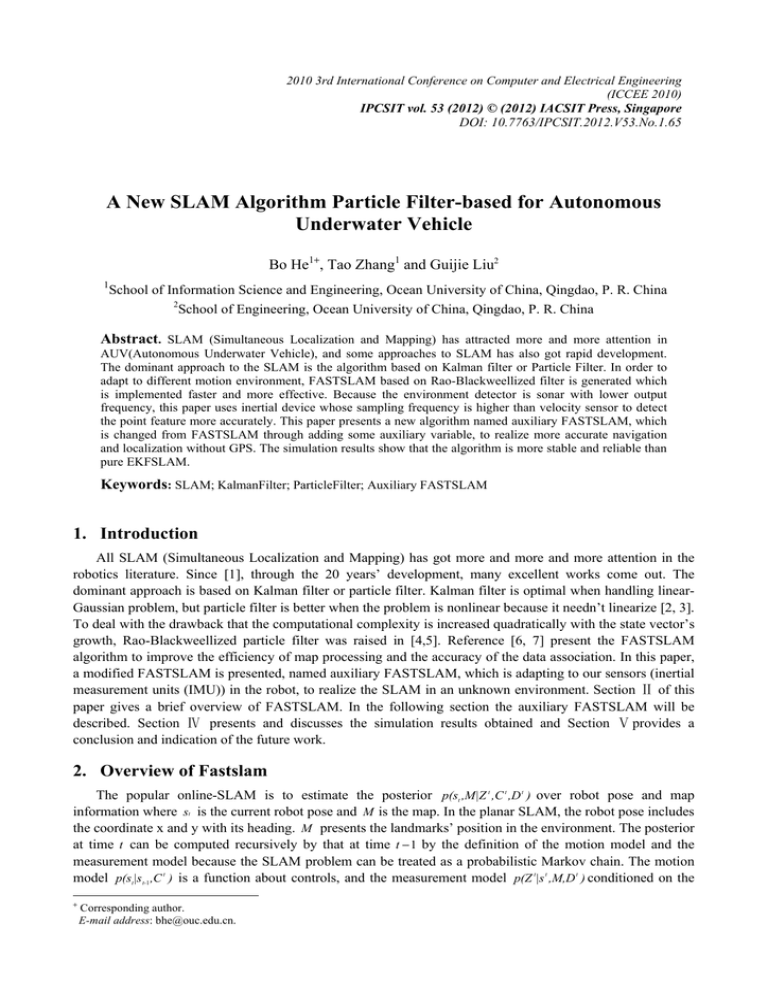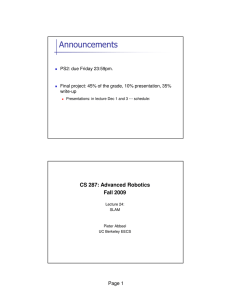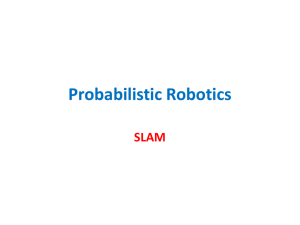A New SLAM Algorithm Particle Filter-based for Autonomous Underwater Vehicle Bo He
advertisement

2010 3rd International Conference on Computer and Electrical Engineering
(ICCEE 2010)
IPCSIT vol. 53 (2012) © (2012) IACSIT Press, Singapore
DOI: 10.7763/IPCSIT.2012.V53.No.1.65
A New SLAM Algorithm Particle Filter-based for Autonomous
Underwater Vehicle
Bo He1+, Tao Zhang1 and Guijie Liu2
1
School of Information Science and Engineering, Ocean University of China, Qingdao, P. R. China
2
School of Engineering, Ocean University of China, Qingdao, P. R. China
Abstract. SLAM (Simultaneous Localization and Mapping) has attracted more and more attention in
AUV(Autonomous Underwater Vehicle), and some approaches to SLAM has also got rapid development.
The dominant approach to the SLAM is the algorithm based on Kalman filter or Particle Filter. In order to
adapt to different motion environment, FASTSLAM based on Rao-Blackweellized filter is generated which
is implemented faster and more effective. Because the environment detector is sonar with lower output
frequency, this paper uses inertial device whose sampling frequency is higher than velocity sensor to detect
the point feature more accurately. This paper presents a new algorithm named auxiliary FASTSLAM, which
is changed from FASTSLAM through adding some auxiliary variable, to realize more accurate navigation
and localization without GPS. The simulation results show that the algorithm is more stable and reliable than
pure EKFSLAM.
Keywords: SLAM; KalmanFilter; ParticleFilter; Auxiliary FASTSLAM
1. Introduction
All SLAM (Simultaneous Localization and Mapping) has got more and more and more attention in the
robotics literature. Since [1], through the 20 years’ development, many excellent works come out. The
dominant approach is based on Kalman filter or particle filter. Kalman filter is optimal when handling linearGaussian problem, but particle filter is better when the problem is nonlinear because it needn’t linearize [2, 3].
To deal with the drawback that the computational complexity is increased quadratically with the state vector’s
growth, Rao-Blackweellized particle filter was raised in [4,5]. Reference [6, 7] present the FASTSLAM
algorithm to improve the efficiency of map processing and the accuracy of the data association. In this paper,
a modified FASTSLAM is presented, named auxiliary FASTSLAM, which is adapting to our sensors (inertial
measurement units (IMU)) in the robot, to realize the SLAM in an unknown environment. Section Ⅱ of this
paper gives a brief overview of FASTSLAM. In the following section the auxiliary FASTSLAM will be
described. Section Ⅳ presents and discusses the simulation results obtained and Section Ⅴ provides a
conclusion and indication of the future work.
2. Overview of Fastslam
The popular online-SLAM is to estimate the posterior p(st ,M|Z t ,C t ,D t ) over robot pose and map
information where st is the current robot pose and M is the map. In the planar SLAM, the robot pose includes
the coordinate x and y with its heading. M presents the landmarks’ position in the environment. The posterior
at time t can be computed recursively by that at time t − 1 by the definition of the motion model and the
measurement model because the SLAM problem can be treated as a probabilistic Markov chain. The motion
model p(st|st-1 ,C t ) is a function about controls, and the measurement model p(Z t|s t ,M,D t ) conditioned on the
+
Corresponding author.
E-mail address: bhe@ouc.edu.cn.
robot pose and the map. To implement the FASTSLAM effectively, the SLAM posterior will be described as
p(s t ,M|Z t ,C t ,D t ) which can be factored into a product of simpler terms. Observations in the environment are
independent each other given knowledge of the robot’s path, so the SLAM posterior can be factored in detail
[6]. Equation (1) can be derived directly:
p(s t ,ΜΜ| t ,C t ,D t )
= p(s t|Z t ,C t ,D t )p(M|s t ,Z t ,C t ,D t )
(1)
m
∏ p(m |s ,Z
= p(s |Z ,C ,D )
t
t
t
t
pathestima tor
t
t
t
t
,C ,D )
i
i =1
landmarkes timators
The leftmost term in (1) can be realized by particle filter and the last term by Kalman filter. Because all
landmarks’ estimate is nonlinear and conditioned on the robot’s path, each particle contains many EKF
processing. If there are n particles, then n • m EKFs will be implemented. Each particle is of the form:
st [j]= s t,[ j ] ,μ1[ ,tj ] , 1[ ,tj ] ,...,μ [m,tj ] , [m,tj ] , where the bracket notation [ j ] indicates the index of the particle; s t,[ j ] is the jth particle’s pose estimate, and μ [m,tj ] , [m,tj ] are the mean and covariance of the m-th feature in the j-th particle.
The whole algorithm of FASTSLAM is just one more step than the pure particle filter [9], and is performed in
four steps: first, a new robot pose will be received by sampling the old particles, then the landmark EKFs
corresponding to the map features are updated or augmented with the new observations. Next, the importance
weight will be computed and the importance resampling will be done for the true posterior at last.
{
∑
∑}
∑
3. Auxiliary Fastslam
In the real underwater situation, velocity sensor has low output frequency, and the environment detector is
sonar with lower frequency. For making the feature detected from environment exactly, this paper uses inertial
device with higher output frequency. But the inertial error accumulates with the time going on, so some
corrections must be done for better results. All the reasons cause the new algorithm named auxiliary
FASTSLAM produced. Velocity in the planar will be treated as both state variable and observation variable.
In the system, state vector is X=[s,M,Vx,Vy ] , where s=[x,y,θ ] is the robot pose. Meanwhile the other sensors will
result in the observation vector Z l=[Vx,Vy] and Z n=[r,ψ] , where superscript l stand s for linear and n nonlinear.
As mentioned above, the whole posterior can be described as p(s t ,vx,vy,M|Z l ,t ,Z n,t ,C t ,D t ) . Equation (2) is the
motion model, and the processing noise is Gaussian and notation is W n=[Nx,Ny,Nθ ] whose mean is zero with
covariance Q n . The measure model is (3),where s in Z n stands for robot pose and m is feature’s position,
and N n has a similar property like W n 。
⎧xt = x t−1 + (vx , t − 1 × Δt + 0.5× ax , t − 1 × Δt × Δt)× cos(θt − 1 )
⎪
− (vy , t − 1 × Δt + 0.5× ay, t−1 × Δt × Δt)× sin(θt − 1 ) + Nx,t − 1
⎪⎪
n
X ⇒ ⎨ y t = y t−1 + (vx , t − 1 × Δt + 0.5× ax, t−1 × Δt × Δt)× sin(θt − 1 )
⎪
+ (vy , t − 1 × Δt + 0.5× ay, t−1 × Δt × Δt)× cos(θt − 1 ) + Ny,t − 1
⎪
⎪⎩θ t = θ t−1 + wt−1 × Δt + Nθ,t − 1
⎧vx t = vx, t−1 + ax, t−1 × Δt + Nv ,t − 1
Xl ⇒⎨
⎩vy t = vy, t−1 + ay, t−1 × Δt + NV ,t − 1
(2)
x
y
⎡V x,t ⎤ ⎡V x,t ⎤
Z l,t = ⎢ ⎥ = ⎢ ⎥ + N tl
⎣V y,t ⎦ ⎣V y,t ⎦
Z
n,t
⎡ (m − x) 2 + (m − y) 2 ⎤
x
y
⎡ r(s,m) ⎤ ⎢
⎥
n
=⎢
=⎢
my − y
⎥
⎥ + Nt
−1
ψ(s,m)
)
θ
tan
(
−
⎣
⎦ ⎢
⎥
mx − x
⎦
⎣
(3)
p(Xl,t|Xn,t,Ct ,Dt )p(Xl,t|Zl,t ,Ct ,Dt )p(Xn,t|Zn,t ,Ct ,Dt )
m
∏p(m|X ,Z ,C ,D )
i
i=1
n,t
n,t
t
t
(4)
⎡ mx − x
⎢
q
Gz = ⎢
⎢my − y
⎢
⎣ q
⎡ x − mx
⎢
q
Gs = ⎢
⎢ y − my
⎢
⎣ q
my − y⎤
⎥
q ⎥
mx − x ⎥
⎥
q
⎦
y − my
q
x − mx
q
X t1 = X t1−1 + Ψ2 × Ct −1 + Wt −1
(5)
⎤
0⎥
⎥
⎥
1⎥
⎦
(6)
z = Cbn × ( X tn − X tn−1 ) − Ψ1 × Ct −1 − Φ × X tl−1 + Cnb × Wt −n1
Tt −1=Φ × Pt −1|t −1×Φ T +Qt −1
n
Lt −1=Pt −1|t −1 × Φ T × Tt −l 1
(7)
Pt −∗1|t −1=Pt −1|t −1 − Lt −1 × Tt −1 × LTt−1
∗
X tl−1|t −1 =X tl−1|t −1+Lt −1 × (z − Φ × X tl−1 )
∧ l
X
t|t −1
=X
∗
l
t −1|t −1
+ L t −1 × (z − Φ × X tl−1 )
(8)
Pt|t∗ −1=Pt −1|t −1 − L t −1 × T t −1 × LTt−1 + Q l
According to the thought in [10], the posterior can be factored into (4) by some conditions because Zn and
X l are independent, meanwhile Z l and X n are independent. The second term in (4) is linear-Gaussian, so
optimal results will be got by Kalman filter. And the last two terms will be handled by FASTSLAM. To the
first term, an algorithm similar to Kalman filter is used to update and predict the last linear state. This makes
the linear state more accurate. And that will cause the nonlinear state more accurate.
The whole algorithm can be summarized as following:
a) Initialize the state vector that will be estimated.
b) Given a new acceleration and angular speed, nonlinear state X n that is the robot pose will be
predicte.
c) If some landmark is observed, then the augment and update about the landmark will be implemented
by EKFs in particles and the Jacobian matrix is (5), where q = (mx − x)2 + (my − y)2 . After this, robot pose will
be updated and importance weight will be computed. If there is no landmark, this step will be skipped and
step four will be implemented directly.
d) If data come from sensor about linear state X l , the Kalman filter will be implemented. If there is no
such data, step five will be directly realized.
e) An optimal pose will be received by dealing with the particles. And then X will be treated as an
observation to update X l by a function that is similar to Kalman filter. The details are demonstrated in (6)
and (7), where Cnb is the transformation matrix from navigation coordinate frame to robot body frame,
n
Ψ 2 and Ψ 1 are transformation matrix about controls, Φ is about the linear model, Pt*−1|t −1 which is notated by a
star * to interpret that this updating result is the covariance before a new control comes. Equation (7) is the
second measurement update process.
f) Equation (8) will help to realize the prediction of X l . And then step two recurs.
4. Simulation Of Auxiliary Fastslam
According to real situation, this paper adopts east-north coordinate frame. Simulated data is a sequence of
acceleration and angular speed. In the simulation, the output frequency of the inertial devices is 20HZ, speed
measurement device is 5Hz, and feature detecting frequency is 1.25Hz. To make the verification of the
algorithm easier, control is only done on east and this will cause error in the north bigger. Both a ground truth
of the robot trajectory and a trajectory with noise are derived by simple dead-reckon. In the Fig.1, the
blue(solid) line stands for the true trajectory ,and the red(dash) is the trajectory added noise. The green dots
which are up to 80 are environment features. Fig.2 is error of path without using SLAM. In this paper, 100
particles are used.
160
true path(m)
landmarks
noise-added path (m)
140
northern position(m)
120
100
80
60
40
20
0
0
100
200
300
400
500
600
eastern position(m)
700
800
900
Figure 1. True robot trajectory, true position of landmarks, and the trajectory added noise
path errors
50
eastern error(m)
north ern error(m)
45
40
35
errors(m)
30
25
20
15
10
5
0
0
100
200
300
400
500
time(s)
600
700
800
900
Figure 2. Error of path without using SLAM
path errors using EKF-Slam
18
eastern error(m)
northern error(m)
16
14
errors(m)
12
10
8
6
4
2
0
0
100
200
300
400
500
time(s)
600
700
800
900
Figure 3. Error of path by using EKFSLAM
This paper shows the results of auxiliary FASTSLAM by comparing pure EKFSLAM. After 900 seconds
simulation, it is clear that after using SLAM, the path of robot is corrected well.
Fig.3 is error by implementing the EKFSLAM, where the biggest eastern error is 2.1 meters and the
northern 16.2 meters. Fig.5 shows the results after using auxiliary
error of landmarks position using EKF-Slam
18
error(m) of eastern direction
error(m) of northern direction
distance error(m)
16
14
errors(m)
12
10
8
6
4
2
0
0
10
20
30
40
50
landmarks marker
60
70
80
Figure 4. Position error of the landmarks by using EKFSLAM
path errors using Auxiliary-FastSlam
1
eastern error(m)
northern error(m)
0.9
0.8
0.7
errors(m)
0.6
0.5
0.4
0.3
0.2
0.1
0
0
100
200
300
400
500
time(s)
600
700
800
900
Figure 5. Error of path by using auxiliary FASTSLAM
error of landmarks position using Auxiliary-FastSlam
1
error(m) of eastern direction
error(m) of northern direction
distance error(m)
0.9
0.8
0.7
errors(m)
0.6
0.5
0.4
0.3
0.2
0.1
0
0
10
20
30
40
50
landmarks marker
60
70
80
Figure 6. Position error of the landmarks by using auxiliary FASTSLAM
FASTSLAM, where the biggest eastern error is 0.51 meters and the northern 0.96 meters. Fig.4 shows the
different position error about landmarks, and the biggest Eustachian distance error is 16.3 meters.
Fig.6 has a smaller distance error that is 1.00 meters. Through table 1, EKFSLAM can diverge easily and
auxiliary FASTSLAM keep the estimate more stable and more accurate.
Table 1. Stability of The Two Algorithms
error
Eastern
path(m)
R
0.04 2
0
0
0.04 2
3.5
EKFSLAM
Northern
Distance of
path(m)
landmarks(m)
17.8
19.7
Eastern
path(m)
0.51
Auxiliary FASTSLAM
Northern
Distance of
landmarks(m)
path(m)
0.97
1.00
0.06 2
0
0
0.06 2
13.8
6.0
69.6
0.49
0.95
0.98
0.08 2
0
0
0.08 2
41.4
10.9
42.4
0.51
0.92
0.94
0
0.12
Diverge
Diverge
Diverge
0.51
0.94
0.97
2
0 .1
0
5. Conclusion And Future Work
Although the dominate EKFSLM can deal with the problem we have confronted, it has low accuracy and
stability. This paper presents a new algorithm named auxiliary FASTSLAM to decrease the computational
complex and implement easily and make the robot path and map more accurate. And the simulated results also
show clearly that auxiliary FASTSLAM is more stable than pure EKFSLAM.
Even though we obtained promising results with our technique, there are still tasks for future work. One
potential problem with the specific algorithm is to combine strapdown inertial navigation (SIN) technology to
realize the 3-dimention environment which has a higher nonlinear degree. And that will make us get a more
flexible algorithm to adapt to more environments.
6. Acknowledgment
This research has been funded in part by the High Technology Research and Development Program of
China (No.2006AA09Z231) and Science and Technology Development Program of Shandong Province
(No.2008GG1055011).
7. References
[1] R. C. Smith and P. Cheeseman, “On the representation and estimation of spatial uncertainty.” International Journal
of Robotics Research, 5(4):56–68, 1986.
[2] N.J. Gordon, D.J. Salmond, and A.F.M. Smith, “A novel approach to nonlinear/non-Gaussian Bayesian state
estimation.” Proc IEEE Radar and Signal Processing, Apr 1993, vol 140, pp. 107-113.
[3] A. Doucet, N. de Freitas, and N. Gordon, editors, “Sequential Monte Carlo Methods in Practice.” Springer Verlag,
2001.
[4] A Doucet, N. de Freitas, K. Murphy and S. Russell, “Rao-Blackwellised particle filtering for dynamic Bayesian
networks.” Proc UAI Conference on Uncertainty in Artificial Intelligence (UAI 2000), pp. 176-183
[5] Schon T, Gustafsson F, and Nordlund P J, “Marginalized particle filters for mixed linear/nonlinear state-space
models”. IEEE Transaction on Signal Processing, , vol 53(7), pp. 2279-2289, 2005
[6] M.Montemerlo and S.Thrun, “Simultaneous localization and mapping with unknown data association using
FastSLAM.” Proc IEEE International Conference on Robotics and Automation (ICRA 2003),. Sept. 2003, vol 2, pp.
1985 - 1991, doi:10.1109/ROBOT.2003.1241885
[7] M.Montemerlo, S.Thrun, D.Koller, and B.Wegbreit, “FastSLAM 2.0: An improved particle filtering algorithm for
simultaneous localization and mapping that provably converges.” Proc IEEE International Joint Conference on
Artificial Intelligence (IJCAI 2003), Citeseer press ,vol 18, pp: 1151-1156 doi: 10.1109/IROS.2006.282528
[8] T. Sch¨on, F. Gustafsson, and P.-J. Nordlund, “Marginalized particle filters for mixed linear/nonlinear state-space
models.” IEEE Transactions on Signal Processing, 2004.
[9] S. Arulampalam and B. Ristic, “Comparison of the particle filter with range parameterized and modified polar
EKF’s for angle-only tracking,” Proc. SPIE, April 2000, vol. 4048, pp. 288–299, 2000, doi:10.1117/12.391985
[10] N. Bergman, “Recursive Bayesian estimation: Navigation and tracking applications,” Ph.D. dissertation, Linköping
Univ., Linköping, Sweden,1999.
[11] Bo He,Ke Yang,Shuai Zhao and Yitong Wang, ”Underwater Simultaneous localization and mapping based on EKF
and point-features,” Proc. IEEE International Conference on Mechatronics and Automation(ICMA 2009). IEEE
Press, Aug. 2009, pp. 4845-4850, doi:10.1109/ICMA.2009.5246398





